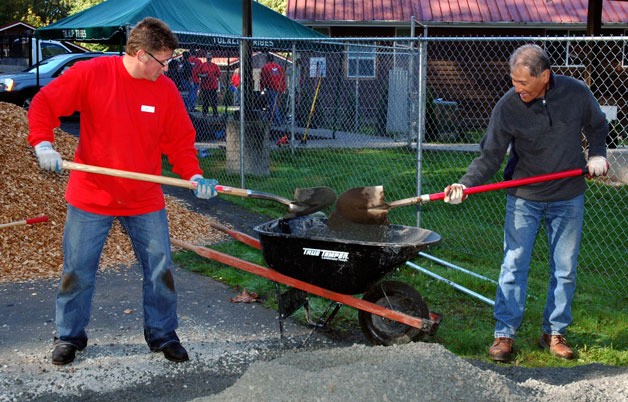TULALIP — The Tulalip Homeless Shelter received some support from an estimated 40 Marysville and Tulalip volunteers Oct. 5, as members of the Marysville office of Keller Williams Realty and the Tulalip Tribes’ Adult Education Services Division conducted improvements on the grounds surrounding the shelter’s six cabins.
Tulalip Tribal Board Chair Mel Sheldon Jr. and Marysville Mayor Jon Nehring both turned out for the first of two planned “We Give Where We Live” projects between the Marysville and Tulalip communities, with the second one set to take place during the spring of next year in Marysville.
“You all deserve credit for coming out here and getting muddy,” Nehring told the workers, as they took a brief break from their landscaping efforts. “We truly value the relationship between local businesses, Marysville community members and the Tribes.”
“We’re reaching across I-5 to show that we care about our people,” Sheldon said. “We realize that we’re all one community, and we’re coming together for those who are less fortunate.”
RoseAnn Green, manager of the Tribes’ Adult Education Services Division, organized the event with Richard Jones, the CEO of Keller Williams Realty in Marysville with whom she went to high school. Green explained that the shelter was established eight years ago and exists to provide temporary lodging for as many as six months to low income, homeless Tulalip Tribal families in crisis who reside in Snohomish County.
“We try to get them back on their feet and out the door within two or three months, but we recognize it might take longer than that for some folks,” Green said. “One young lady with three kids just moved out after only eight weeks. We hook these people up with Temporary Assistance for Needy Families and local real estate people to try and find them homes and even cover their first and last months’ rent.”
The shelter is located across the road from the Tribal Family Service Center. The shelter program also provides case management, budgeting classes and access to the Tribes’ extensive social services program. From 2007 to 2009, 55 families resided at the shelter, with 42 of those families eventually moving into permanent housing. Green sees the shelter as a means of honoring the teachings of her grandmother, Bernice Williams, the oldest member of the Tribes, who turns 100 in December.
“Grandma, along with my mom and dad, always taught us the importance of community service and helping others,” Green said.



